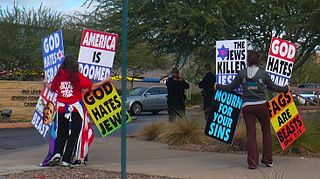Related Research Articles
Antisemitism is hostility to, prejudice towards, or discrimination against Jews. This sentiment is a form of racism, and a person who harbours it is called an antisemite. Though antisemitism is overwhelmingly perpetrated by non-Jews, it may occasionally be perpetrated by Jews in a phenomenon known as auto-antisemitism. Primarily, antisemitic tendencies may be motivated by negative sentiment towards Jews as a people or by negative sentiment towards Jews with regard to Judaism. In the former case, usually presented as racial antisemitism, a person's hostility is driven by the belief that Jews constitute a distinct race with inherent traits or characteristics that are repulsive or inferior to the preferred traits or characteristics within that person's society. In the latter case, known as religious antisemitism, a person's hostility is driven by their religion's perception of Jews and Judaism, typically encompassing doctrines of supersession that expect or demand Jews to turn away from Judaism and submit to the religion presenting itself as Judaism's successor faith—this is a common theme within the other Abrahamic religions. The development of racial and religious antisemitism has historically been encouraged by anti-Judaism, though the concept itself is distinct from antisemitism.

There have been Jewish communities in the United States since colonial times, with individuals living in various cities before the American Revolution. Early Jewish communities were primarily composed of Sephardi immigrants from Brazil, Amsterdam, or England.
The history of antisemitism, defined as hostile actions or discrimination against Jews as a religious or ethnic group, goes back many centuries, with antisemitism being called "the longest hatred". Jerome Chanes identifies six stages in the historical development of antisemitism:
- Pre-Christian anti-Judaism in Ancient Greece and Rome which was primarily ethnic in nature
- Christian antisemitism in antiquity and the Middle Ages which was religious in nature and has extended into modern times
- Muslim antisemitism which was—at least in its classical form—nuanced, in that Jews were a protected class
- Political, social and economic antisemitism during the Enlightenment and post-Enlightenment Europe which laid the groundwork for racial antisemitism
- Racial antisemitism that arose in the 19th century and culminated in Nazism
- Contemporary antisemitism which has been labeled by some as the new antisemitism
This article is a list of countries where antisemitic sentiments have been expressed.
Antisemitism in universities has taken place in many countries at various times. Antisemitism has been manifested in various policies and practices, such as restricting the admission of Jewish students by a Jewish quota, or ostracism, intimidation, or violence against Jewish students, as well as in the hiring, retention and treatment of Jewish staff. In some instances, universities have supported antisemitic government or social policies and condoned the development of antisemitic cultures on campus. In many jurisdictions, especially since World War II, discriminatory practices, including within the context of a university, are in breach of anti-discrimination laws, though antisemitic cultural values still persists on many campuses.

Different opinions exist among historians regarding the extent of antisemitism in American history and how American antisemitism contrasted with its European counterpart. Earlier students of American Jewish life minimized the presence of antisemitism in the United States, which they considered a late and alien phenomenon that arose on the American scene in the late 19th century. More recently however, scholars have asserted that no period in American Jewish history was free from antisemitism. The debate about the significance of antisemitism during different periods of American history has continued to the present day.
Antisemitism —prejudice, hatred of, or discrimination against Jews— has experienced a long history of expression since the days of ancient civilizations, with most of it having originated in the Christian and pre-Christian civilizations of Europe.

Antisemitism has existed for centuries in the United States. Most Jewish community relations agencies in the United States draw distinctions between antisemitism, which is measured in terms of attitudes and behaviors, and the security and status of American Jews, which are both measured by the occurrence of specific incidents. FBI data shows that in every year since 1991, Jews were the most frequent victims of religiously motivated hate crimes, according to a report which was published by the Anti-Defamation League in 2019. Evidence suggests that the true number of hate crimes against Jews is underreported, as is the case for many other targeted groups. In an attempt to combat anti-Semitism, the Biden administration launched the United States’ first-ever comprehensive U.S. National Strategy to Counter Antisemitism on May 25, 2023.
Antisemitic incidents escalated worldwide in frequency and intensity during the Gaza War, and were widely considered to be a wave of reprisal attacks in response to the conflict.
Antisemitism in Canada is the manifestation of hostility, prejudice or discrimination against the Canadian Jewish people or Judaism as a religious, ethnic or racial group. This form of racism has affected Jews since Canada's Jewish community was established in the 18th century.

The Anti-Defamation League (ADL), formerly known as the Anti-Defamation League of B'nai B'rith, is a New York–based international Jewish non-governmental organization and advocacy group that specializes in civil rights law and combatting antisemitism and extremism.
Since World War II, antisemitic prejudice in Italy has seldom taken on aggressive forms.
Antisemitism in the United Kingdom signifies hatred of and discrimination against Jews in the United Kingdom. Discrimination and hostility against the community since its establishment in 1070 resulted in a series of massacres on several occasions and their expulsion from the country in 1290. They were readmitted by Oliver Cromwell in 1655.
Religious discrimination in the United States is valuing or treating a person or group differently because of what they do or do not believe. Specifically, it occurs when adherents of different religions are treated unequally, either before the law or in institutional settings such as employment or housing.
Antisemitism in Venezuela has occurred throughout the history of the Jews in Venezuela. However, under the presidencies of both Hugo Chávez and Nicolás Maduro, allegations of antisemitism grew following actions and statements by the Venezuelan government, while also occurring in public incidents. The Bolivarian government would also use the words of "Jewish" and "Zionist" interchangeably in order to avoid accusations of antisemitism.

Jewish on Campus is a student-led Jewish nonprofit organization dedicated towards addressing discrimination against Jewish college students.
The history of Antisemitism in Maryland dates to the establishment of the Province of Maryland. Until 1826, the Constitution of Maryland excluded Jewish people from holding public office. Prior to the passage of the 1968 Fair Housing Act, Jewish people were excluded from living in many white Christian neighborhoods throughout Maryland due to the use of restrictive covenants and quotas. Between the 1930s and 1950s, quota systems were instituted at universities in Maryland to limit the number of Jewish people. During the 2010s and 2020s, Maryland has seen an increase in reported incidents of antisemitic vandalism and violence.
The history of Antisemitism in Virginia dates to the establishment of the Colony of Virginia. Jews living in colonial Virginia had more rights than most Jews elsewhere in the world, but they did not begin to have equal rights with Christians until after the American Revolution. During the Civil War, Virginian Jews were often the subject of antisemitic accusations of profiteering and disloyalty to the Confederacy. In the early 20th century, educational institutions such as the University of Virginia used anti-Jewish quotas to reduce their number of Jewish students. Prior to the passage of the 1968 Fair Housing Act, some neighborhoods in Virginia excluded Jews using restrictive covenants. During the 2010s and 2020s, Virginia has seen an increase in reported incidents of antisemitic vandalism and violence.
The history of Antisemitism in New Jersey dates to the establishment of the Province of New Jersey. Prior to the passage of the 1968 Fair Housing Act, Jewish people were excluded from living in many white Christian neighborhoods throughout New Jersey due to the use of restrictive covenants and quotas. Between the 1920s and 1950s, quota systems were instituted at universities in New Jersey to limit the number of Jewish people, including at Rutgers University and Princeton University. During the 2010s and 2020s, New Jersey has seen an increase in reported incidents of antisemitic vandalism and violence.
The history of Antisemitism in Connecticut dates to the establishment of the Connecticut Colony. Prior to the passage of the 1968 Fair Housing Act, Jewish people were excluded from living in many white Christian neighborhoods throughout Connecticut due to the use of restrictive covenants and quotas. Between the 1920s and 1960s, quota systems were instituted at universities in Connecticut to limit the number of Jewish people, including at Yale University and Wesleyan University. During the 2010s and 2020s, Connecticut has seen an increase in reported incidents of antisemitic vandalism and violence.
References
- ↑ "Florida Jewish Heritage Trail". Florida Department of State . Retrieved 2023-11-07.
- ↑ McIver, Stuart B. (2008). Touched by the Sun. Vol. 3. Sarasota, FL: Pineapple Press. p. 168. ISBN 978-1-56164-206-9.
- ↑ "The Jews of Florida: A History". Aish.com . Retrieved 2023-11-07.
- ↑ "Florida Supreme Court Rule Voids Anti-jewish Restrictive Covenants". Jewish Telegraphic Agency . Retrieved 2023-11-07.
- ↑ "Remembering Miami Beach's Shameful History of Segregation and Racism". Miami New Times . Retrieved 2023-11-07.
- ↑ "100 Years: The Dark and Dirty History of Miami Beach". Miami New Times . Retrieved 2023-11-07.
- ↑ "PR: Antisemitic Incidents In Florida More Than Double Since 2020". Anti-Defamation League . Retrieved 2023-11-07.